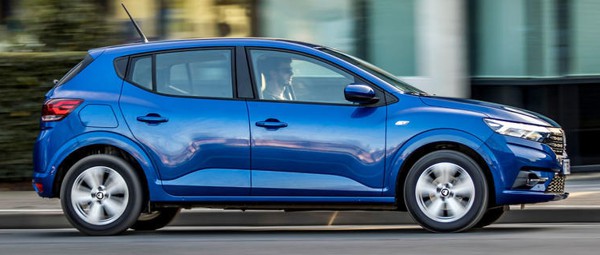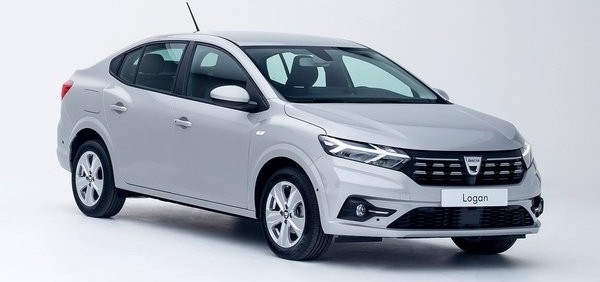Published
on 1
Mar 2021
|
All rights reserved.
|
|
|

|
|
A-segment
price for B-segment ingredients and C-segment practicality. It's a
sharp contrast to Fiat 500 Electric.
|
|
Introduced in 2005, Dacia
Logan and Sandero were the cheapest cars you could buy in Western
Europe, starting from as low as €7500. Before the pandemic, their
combined sales was over 600,000 units a year (including Renault-badged
versions), making them one of the best selling European cars.
Today, the third generation Logan and Sandero continue to be the
cheapest cars available. Starting price has risen slightly to €8700 in
France, which is half the price of a typical B-segment supermini.
That’s for the leanest equipped, weakest powered (1.2-liter 65hp)
model, of course. However, even a decently equipped and powered model
is 25 percent cheaper than its comparable rivals. No wonder it is so
popular.
Like the last but not the first generation, Logan and Sandero are
basically the same car in different body styles – sedan for the former
and hatchback for the latter. In Europe, the hatchback outsells the
sedan by about 6 to 1. Outside Europe, they are evenly matched. Here,
we concentrate on the Sandero, but virtually all the findings could be
applicable to Logan as well.

|
|
The
new Dacia duo is built on the CMF platform of the latest Renault Clio.
|
|
The new Sandero looks more like a normal European hatchback. Although
the fascia still looks hardly elegant, there are more styling tweaks in
its body shell. In addition to a lower and wider stance, it looks not
only larger but also sportier. Surprisingly, the new car is no longer
built
on an outdated and cheapened version of Renault platform, but the same
CMF platform as the current Renault Clio. Compared with the old car, it
gets slightly longer, a massive 115mm wider and 19mm lower. Wheelbase
is 15mm longer.
The extended dimensions are evident in cabin. Rear legroom has grown by
42mm, making the rear seats accommodative for 6-footers behind
6-footers. The extra width makes a 5th passenger tolerable, which is
rare in the supermini class. The boot is also competitive at 328
liters, or 528 liters for Logan. In other words, you pay the price of
an A-segment car for the interior space approaching a C-segment car.
That's the biggest attraction of the Dacia.

|
|
The interior
finally has some style and build quality to speak of.
|
|
Cabin design has taken a major step forward as well. Instead of the
boring, cheap-looking environment of the old, it finally has some style
to speak of. Materials aren’t as high-quality as typical superminis, as
all plastics are hard, but at least in top-spec. model there are some
padded textile materials covering the prominent surfaces of dashboard
and door handles, which lift the ambience a lot. The seats are quite
comfortable. The steering wheel finally adjusts for reach and rake.
There is an 8-inch touchscreen infotainment system on top model whose
rims are comically thick but it operates okay. Unlike its more upmarket
rivals, the Dacia has yet to switch to touchscreen or touch-sensitive
buttons for most functions. That’s actually a good news, as you can
adjust air-con and audio easily with conventional switchgears. The
conventional instrumentation might be boring to read, but they function
just as well. Many motorists prefer to skip unnecessary sophistications
and keep money in their pockets. Dacia should please them.
Likewise, there is no need to offer a wide range of engines, just
sticks to the essentials. Apart from the aforementioned entry-level
engine, most buyers are likely to select Renault’s 1.0 TCe turbocharged
triple with 90 horsepower. It is not as powerful or as eager as the
100hp version on Clio, but compared with the old 0.9-liter unit it runs
smoother and offers more low to mid-range torque. Not a bad engine for
a budget car. The new 6-speed manual gearbox is decent, too. The car
can run 0-60 mph in a passable 11 seconds and top 111 mph. No fireball
for sure.

|
|
Logan is a
Sandero with a boot.
|
|
Predictably, the chassis is set for comfort. The soft suspension copes
well with broken roads. The steering is light, the body rolls more than
the class norm in corners, and understeer appears sooner than desired.
This is not a chassis designed for driving excitement, but tuned to
satisfy the basic needs of taking you to work or shop. However, it is
definitely more competent than the old car, with improved body control
and grip.
If there is anything clearly showing its low cost, it must be NVH
suppression. While most superminis nowadays offer “big car” refinement,
the Dacia is not there yet. The engine is noisier under acceleration.
The cabin is hampered by excessive wind and tire noise when cruising at
high speed. The use of CMF platform does not necessarily include the
same level of sound deadening materials and seals as its Renault Clio
sister.
That’s the price you pay for a low price.
Still, considering how much the Dacia duo undercuts other B-segment
superminis, the sacrifice in refinement is understandable. Think in
this way: if you buy an A-segment mini car for the same money, you get
no better refinement yet much less space and practicality. Dacia just
gives you a smarter option.
|
Verdict:     |
|